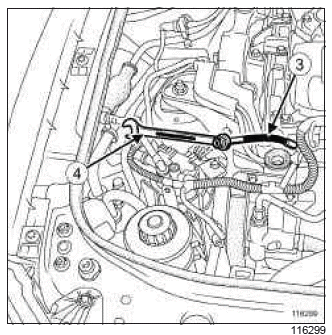Renault Clio: Pressure at end of compression: Check
K9K

- Remove the heater plugs (see 13C, Preheating, Heater plugs: Removal - Refitting, 13C-2).

- Disconnect:
- the pressure regulation solenoid valve connector (1),
- the flow control solenoid valve connector (2),
- Fit the hose end piece (Mot. 1592) in place of one of the removed plugs.

- Moderately tighten the hose end piece (Mot. 1592) using an open-jawed spanner.

- Moderately tighten the diesel compression gauge on the hose end piece (Mot. 1592).
- Connect a self-contained starter or an automatic battery charger.
- Vehicle which is equipped with RENAULT Card:
- run command SC003 Save computer data,
- run command RZ019 Reinitialise programming,
- run the starter for at least 15 seconds until the compression gauge needle stabilises to obtain the maximum value,
- open the discharge valve to release all of the pressure in the compression gauge,
- proceed through the diagram sheet,
- carry out the same procedure for the other cylinders,
- run command SC001 Write computer data.
- For vehicles equipped with keys, follow the starting
cycle until the compression gauge needle stabilises
to obtain the maximum value:
- open the discharge valve to release all of the pressure in the compression gauge,
- proceed through the diagram sheet,
- carry out the same procedure for the other cylinders
Note: The pressure value after compression must be at least 18 bar.
- Disconnect the self-contained starter or automatic battery charger.
- Loosen:
- the diesel compression gauge on the hose end piece (Mot. 1592),
- the hose end piece (Mot. 1592) using an open-jawed spanner.
- Remove the hose end piece (Mot. 1592) which was fitted in place of one of the removed plugs.
- Connect:
- the connector to the pressure regulation solenoid valve,
- the flow control solenoid valve connector,
- Refit the heater plugs (see 13C, Preheating, Heater plugs: Removal - Refitting, 13C-2).
- Using the Diagnostic tool, check for the absence of stored faults in the computers; deal with any faults and clear them if necessary.
D4F

CHECK
I - PREPARATION OPERATION FOR CHECK
- Remove the plugs (see 17A, Ignition, Plugs: Removal - Refitting, 17A-11).
Note: Use a petrol compression gauge compatible with the special tools.
The petrol compression gauge must be equipped with a universal end piece (rubber), or a gaz 1/4 thread bolt.

- Connect a petrol compression gauge (1).
- Run command with Diagnostic tool :
- RZ009: VEHICLE FUNCTION PROGRAMMING,
- VP036: FUEL SUPPLY INHIBITION.
- Put the vehicle under the starting conditions by positioning the gear lever in neutral.
II - TEST OPERATION
- Activate the starter until the needle of the petrol compression gauge stabilises.
- Measure the cylinder compressions, cylinder by cylinder.
- Fully depress the accelerator pedal in order to open the throttle valve during the compression measurements.
Note: It is necessary to wait for at least 10 seconds before starting the engine each time (the starter will not run due to its thermal protection).
III - FINAL OPERATION
- Disconnect the petrol compression gauge.
- Refit the plugs (see 17A, Ignition, Plugs: Removal - Refitting, 17A-11).
- Run command VP037: "STOP INHIBIT FUEL SUPPLY" using the Diagnostic tool.
- Start the engine.
Note: If the engine does not start, run command VP037: STOP FUEL SUPPLY INHIBITION using the Diagnostic tool or switch off the ignition and wait 1 min before starting the engine again.
K4M

CHECK
I - PREPARATION OPERATION FOR CHECK
- Remove:
- the coils (see 17A, Ignition, Coils: Removal - Refitting, 17A-2),
- the spark plugs (see 17A, Ignition, Plugs: Removal - Refitting, 17A-11).

- Connect a petrol compression gauge (1).
- Put the vehicle under starting conditions:
- gear lever in neutral position for manual gearbox,
- gear lever in position P (park) for an automatic gearbox.
- Disconnect the injector connectors.
II - TEST OPERATION
- Activate the starter until the needle of the petrol compression gauge stabilises.
- Measure the compression of the engine, cylinder by cylinder.
- Fully depress the accelerator pedal in order to open the throttle valve during the compression measurements.
Note: It is necessary to wait for at least 10 seconds before starting the engine each time (the starter will not run due to its thermal protection).
III - FINAL OPERATION
- Disconnect the petrol compression gauge.
- Refit:
- the spark plugs (see 17A, Ignition, Plugs: Removal - Refitting, 17A-11),
- the coils (see 17A, Ignition, Coils: Removal - Refitting, 17A-2).
- Connect the injector connectors.
- Using the Diagnostic tool, check that there are no faults stored in the computer.
- Start the vehicle.

